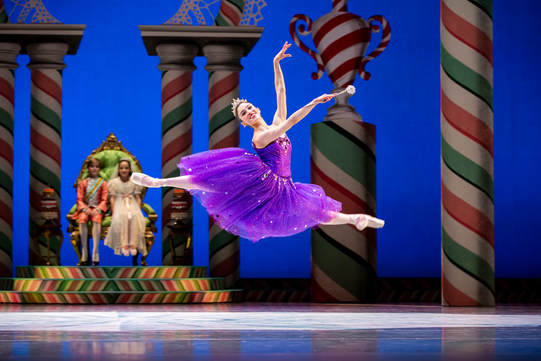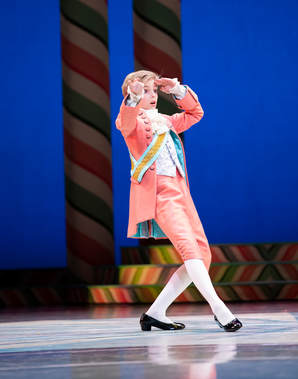 Leta Biasucci as the Sugar Plum Fairy. Photo © Angela Sterling. Leta Biasucci as the Sugar Plum Fairy. Photo © Angela Sterling. I've never reviewed The Nutcracker. There was never much I wanted to say about it publicly, even when the Seattle ballet-loving public mourned the loss of the beautifully mysterious Maurice Sendak/Kent Stowell version after Pacific Northwest Ballet switched to George Balanchine's Nutcracker in 2015. For me, Nutcracker was always an easy Christmasy uplift, a way to get lost in the sparkle of traditional classical ballet, a bump in memory that made me feel twenty or thirty years younger for a few days afterward. But in all of that it was always just a comfort ballet with nothing mind-blowing or weird enough to pitch to an editor. Until this year. On opening night, newly promoted PNB principal dancer Leta Biasucci's Sugar Plum Fairy blew my mind. Biasucci is a favorite for many; her dancing is sharp and exacting, her smile authentic, her stage presence making every character she dances immediately believable and adored. But lately Biasucci's technique is more refined and mature, surpassing her previous tendencies to sometimes rush through steps and hide her deeper personality and artistry from the her audience. Now she adds just the right amount of time and physical presence to the end of her movements so that her extended fingertips, feet, or facial profile are as stunning as the difficult step she's just completed. At the risk of sounding cheesy, Biasucci paints a picture with the emotion and energy of each movement and with her increasing technical skills she has the promise of becoming one of the greats. And I'm not the only one who thinks so--even the tiny chatty balletomane behind me only spoke once during Biasucci's and principal dance Lucien Postlewaite's pas de deux, "MOM, she's soooo beautiful!" Check out the end of Leta and Lucien's standing ovation-worthy grand pas here on PNB's Instagram. Another memorable performance on opening night was young dancer Jack Kaspar's Nathaniel, Drosselmeier's nephew turned Little Prince. Dancing these important roles is understandably overwhelming for many young Nutcracker dancers and sometime that stress shows up in a lack of energy and enthusiasm in the characters that need to communicate a big part of the ballet's storyline. This year Jack Kaspar's classy, smiley stage presence and impressive miming skills brought a lot of fun to the potentially boring-as-heck beginning of Act II, and his battle and party scene performances were pretty darn good too. Keep rocking, Jack Kaspar. Also noteworthy were exceptional performances by Joshua Grant as Dr. Stahlbaum, Seth Orza as Drosselmeier, Angelica Generosa as the Marzipan Shepherdess, and Toy Soldier Kyle Davis. So what's different? What's going on in the company this season to make everyone shine like this? What's going on in the dancers' lives? What do they think about while they're dancing? When I write criticism for publication, I often ask the art creators about this stuff but I've never asked it of a dancer performing the work of other choreographers. Maybe I should. Balanchine's Nutcracker choreography has been performed god knows how many times since its 1954 New York City Ballet premiere but each dancer must put their own mysterious, indelible artistic mark on it to become as good as Biasucci's performance on Friday night.
1 Comment
Jamie Crowley
11/25/2018 10:53:16 pm
I didn’t see this particular production, but I read and enjoyed the blog. I look forward to more of your reviews/articles.,
Reply
Leave a Reply. |
AuthorMother Archives
September 2022
Categories
All
|

 RSS Feed
RSS Feed
